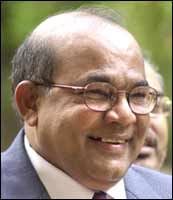Home > Business > Interviews
The Rediff Interview/Y V Reddy, Governor, Reserve Bank of India
'We must prepare for 8% growth over the next
2-3 years'
November 04, 2003
 Immediately after announcing a Credit Policy that apparently focuses more on continuity than change, Reserve Bank of India Governor Y V Reddy met Business Standard to explain his agenda for change. Excerpts from the interview:
Immediately after announcing a Credit Policy that apparently focuses more on continuity than change, Reserve Bank of India Governor Y V Reddy met Business Standard to explain his agenda for change. Excerpts from the interview:
You spoke about continuity with change. There seems to be only continuity but no change.
Continuity is important, but change cannot happen overnight. You have to prepare the system for change. Given the way things are building up, we must prepare the institutional set-up and the monetary framework for higher levels of growth.
Towards this end, you can see three or four measures of change. First, the emphasis on credit delivery. Once the economy picks up as we had indicated in August, we expect credit to pick up. When credit demand picks up, adequate liquidity will be provided. Second, credit pricing.
In some sectors, lending rates have come down, in others they are yet to come down. Greater transparency is required, and we have to see that it percolates. Third, the issue of unhedged foreign exchange exposures.
Earlier there was persuasion, but now we have asked banks to put in place a policy that recognises the possible impact of any foreign exchange volatility, how much ever it may be moderated on corporate balance sheets.
With so much of emphasis on credit delivery, are you making monetary policy development-oriented?
In the last 10 years, we had two major pillars: growth and stability. But with greater liberalisation and links to external markets, there is the issue of financial stability. So now the monetary policy framework is dependent on three pillars: growth, price stability and financial market stability.
If we consider 1997-2002, what are the global situations India faced? We faced the Asian crisis, US sanctions, the Kargil war and political uncertainties.
Naturally, in such uncertain situations the policy will be more attached to stability in the financial markets. But today, with the strengthening of the external sector, reasonable price stability and overall growth, distribution issues come to the fore.
Fortunately, so far policies have aided in bringing about growth. Besides restructuring in the corporate sector and industry, growth has been led by the services sector. Now growth, whether it is in the infrastructure or manufacturing sectors, has to be deeper.
At this stage, having captured all the productivity gains so far, I expect investment demand and credit requirement to go up. Credit availability will have to be deeper and wider. It is in this context that we are trying to prepare the institutions.
What have you done to improve credit pricing and transmission of lower interest rates to all sectors?
What we are trying to do is to create a macro enabling environment in terms of liquidity and credit availability, and an institutional structure to take bank credit where it is most required.
We recognise that in the informal credit market in rural areas, interest rates are very high. We created nationalised banks, co-operative banks and so on.
Despite all our institutional efforts to deliver credit to these sectors, we have not succeeded. There are rigidities in the system, and now there is greater urgency to put this in place.
If panchayats can distribute credit, we are willing to recognise them. In the policy statement, I have said the agricultural credit committee will explore the scope for involving innovative, location-specific catalytic agents to bridge the gap between banking institutions and demand for timely credit in rural areas. Credit kiosks, like STD phone booths, are an option that we are discussing.
What rate of growth do you expect?
My assessment is that we are on the threshold of a high growth trajectory. If the public policy framework continues to be favourable, the RBI's estimate of 6.5-7 per cent growth is conservative. One should prepare for at least 8 per cent growth on average over the next 2-3 years.
What will this growth translate into in terms of credit demand?
Traditionally, it has been in the range of 14-15 per cent. Except some elements of the infrastructure component, the capital or investment intensity of growth may not be as observed in the past.
Why haven't you dropped rates and injected liquidity in anticipation of higher demand?
Our main consideration is appropriate liquidity in the economy. In providing appropriate liquidity, to some extent the global liquidity is given. Our ability to control global liquidity is limited. The link between domestic and global liquidity can be operated partly by the relative prices of money flows and partly by the control mechanism of commercial borrowings, among others.
Still, these are limited instruments. To the extent that these are autonomous variables, we can only modulate domestic liquidity.
Powered by 